Yokohama Municipal Tramway Museum
By Hiroshi Naito
Yokohama city once boasted an approximately 52 km long tramway
(street car) network which thrived especially in the 50s and the early
60s. Its origin dated back to the Yokohama Electric Railway, a private
sector, operator, which commenced service in 1904. It started tram
operation with twelve cars on a 5.6 km segment connecting the national
railway's Kanagawa station to Oebashi (Oe-bridge) in the downtown area.
The tram business was successful, and the network expanded, reaching 40
km in total route-km by 1920, covering downtown Yokohama, with some
radiating segments linking to some major city sub-centers. However, the
service soon fell into difficulty due to the economic panic which hit
just after WWI. In 1921, to resolve this situation and maintain
convenient transport means for Yokohama citizens, the city government
took over the tram system, creating the Yokohama Municipal Tramway.
In the 60s, the drastically increasing number of automobiles
worsened traffic conditions in the city. The tram service became
regarded as a nuisance that prevented from a smooth traffic flow on the
roads. As was the case in other big cities like Tokyo and Osaka, the
service started shrinking due to the mistaken policy of the city
government, which erroneously learned lessons from cities in foreign
countries, especially in the USA. In 1972, the Yokohama Municipal
Tramway finally ceased its 68 years' history.
The Yokohama Municipal Tramway Museum opened in 1973 in
commemoration of the glorious history of the Yokohama Tramway. It is at
the corner of a former tram depot located south of downtown Yokohama,
which converted to a bus depot of the city's Transport Bureau as the
result of the closure of the tram service. The museum preserves seven
Yokohama tram cars under indoor conditions at the ground level of a
public apartment building, although they are all limited to static
display. Its collection includes type 500, a 1928 built two-axle car,
which looks modern with its livery in two-tone color, and type 1500,
introduced in 1957 as a high-performance car built following the P.C.C
technology.
With these beautiful tram cars at the exhibition site, you can feel
as if you are in a real tram shed. Attractions other than the tram car
display are an O gauge layout, which is the largest in scale among
model railways in Japan, associated with a HO scale layout, and a N
gauge layout. In addition, you will be attracted by a number of model
trains of old steam locomotives, coaches, EMUs and DMUs in both O gauge
and HO gauge exhibited in showcases. Most of them are donations from
the family of the late Mr. Yoshimura, who was a railway enthusiast
living in Yokohama. You can learn the history of the tramway and what
the network was like from an assortment of old photos and materials
including an actual large-scaled route map displayed in a section near
the museum entrance. Never miss the great experience of driving a
subway train in a train simulator, which is modeled on Yokohama
Municipal Subway type 2000 EMU. You will be able to operate the train
from Kami-Nagaya station towards Kannai station, the center of down
town Yokohama, through Kamiooka station, in a realistic subway train
cab situation. Do not be afraid of driving a train even if for the
first time. A museum employee will assist you in operating the train.
The location of the Yokohama Municipal Tramway Museum is near JR
Negishi station on the Negishi Line, about a 10-minute ride from
Yokohama by a Keihin-Tohoku through service train. From Negishi
station, take a bus on route #21/#78 to Shiden-Hozonkan, the end of the
service. It will be about a 7-minute bus ride. A taxi may conveniently
take you to the museum. The museum is open daily except on Mondays and
the year-end/new-year holidays.
Further information maybe found on the website for the Yokohama Municipal Tramway Museum (Japanese Text).
| Roster of Museum |
| Number |
Type |
Built |
Builder |
Remarks |
| 523 |
500 |
1928 |
Kamata Sharyo |
half-steel built 2-axle car |
| 1007 |
1000 |
1928 |
Kamata Sharyo |
first bogie car with 3 doors |
| 1104 |
1100 |
1936 |
Umehachi Sharyo |
bogie car called Romance Car |
| 1311 |
1300 |
1947 |
Kisha Works |
built for mass transportation after WWII |
| 1510 |
1500 |
1951 |
Hitachi |
high-performnce car with two front windows |
| 1601 |
1600 |
1957 |
Yokohama Transport Bureau |
the last type of car to be introduced |
| Ka10 |
1948 |
|
Yokohama Sharyo |
motor-powered open wagon |
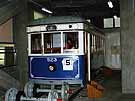
#523, type 500, half-steel made 2-axle car built in 1928. The car looks modern in spite of its vintage.
|
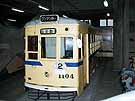
#1104, type 1100, was called Romance Car when it was introduced before World War II.
|
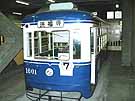
#1601, type 1600, was the final version of the Yokohama tram fleet.
|
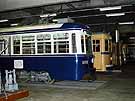
A side view of #1601, with other tram cars exhibited in a row.
|
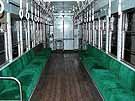
The neat interior of #1104 well retains the feeling of old good tram days.
|
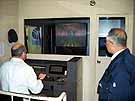
Train driving simulator of Yokohama Subway type 2000 stock.
|
[Home Page]





